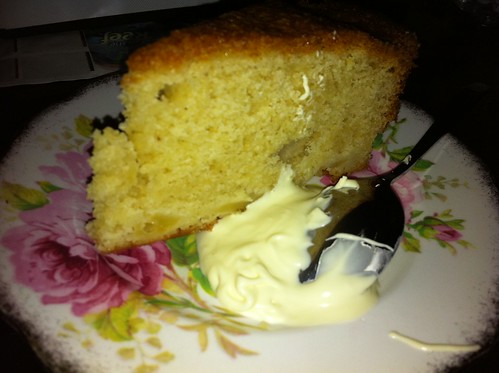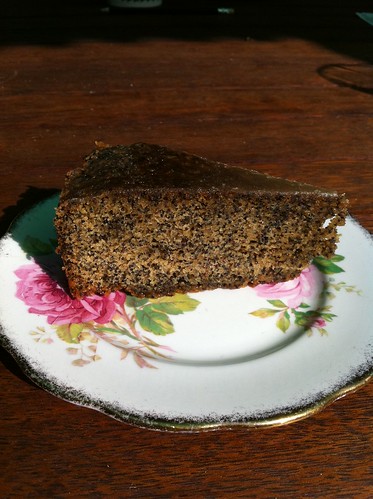We have an apple tree. Last year we didn’t see a single apple – not sure if it was the lack of rain or the local wildlife. In fact, we didn’t even KNOW it was an apple tree.
This year, the planets lined up and, about a week ago, I picked our small harvest. Some research (thanks google!) suggests that our tree might be a Grimes Golden – the apples are like Golden Delicious but tastier and the fruit is very late. Anyway, what to do with all these apples?
If you’re me, the obvious answer is to make cake. A bit of research saw me with a selection of apple cake recipes that didn’t quite fit what we had in the house and some which did, but seemed a bit unexciting. In the end, my cake was very similar to the Dorset apple cake which you can find on both the Delicious website and over at the Goddess’s Kitchen (Maria does loads of baking – if you like cake I suggest you check out her blog).
This is, essentially, a pound cake with apples added. It’s easy and quick to put together but does require a slightly longer cooking time than many cakes. Because I was adding chopped apple at the end, I used my KitchenAid rather than the Magimix for this one. Of course, there’s no harm in doing things by hand, either!
Preheat oven to 180°C (160°C fan). Grease and base line a 23 cm spring form tin.
Begin by softening 225g of unsalted butter. It’s freezing* in Adelaide at the moment and I’m never organised enough to leave butter out so it was the microwave to the rescue. Mix this with 225g of caster sugar and, when the butter/sugar mix is smooth, add 225 self raising flour and 2 tsp of baking powder.
This will be a stiff mixture so now add 3 large eggs, one at a time. Add 25g of ground almonds and 1 teaspoon of allspice.
Peel and cube apples so that you end up with about 300g of apple ready to go in the cake mix. As you work with the apples, toss them in a little lime juice mixed with lime zest which will stop them going brown and will add some crispness of flavour to the finished product.
Gently stir the apples through the cake batter and spoon into the cake tin. Smooth the top as best you can and make sure you push the mix out to the edges. It is quite thick and difficult to manage but you don’t want a lopsided cake.
In my oven, at 160°C fan the cake took an hour to cook. A skewer wants to come out cleanly and the top needs to be set.
The cake kept quite well – thanks to ground almonds. It had lovely caramelised crunchy bits around the sides and if you were after more of this, you could sprinkle the top with a tablespoon of demerara sugar before baking. Everyone liked this cake: it had a good apple flavour and the allspice added a warm lift. And served with cream – what’s not to like?
* I may be exaggerating … but it is pretty cold!



